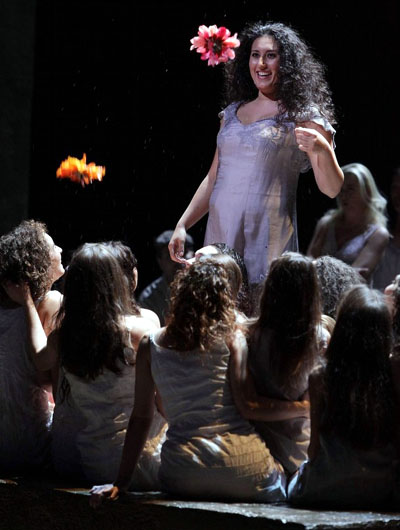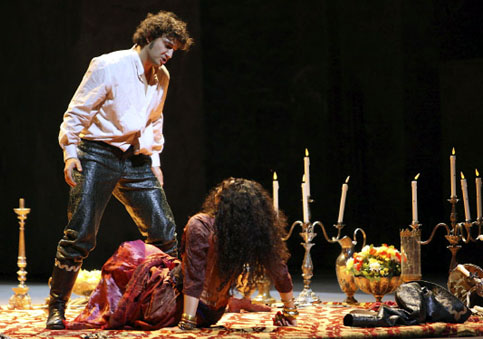
[Anita Rachvelishvili before her admirers]
If I were to reduce to a single word Anita Rachvelishvili’s La Scala debut yesterday as Carmen (the HD simulcast of which I saw at Symphony Space), it might be “sovereignty.” She reigned supreme. This Carmen was the center around which all else could only hope to hold and the sole circumference of her own self. Men in heat fanned themselves and fell aside. Women melted toward her like heliotropes to the sun. During the Habanera, elevated atop a mere water trough outside her factory, she was a radiant and pungent Venus, rising out of the blander foam of humanity. That is, even if one would want from the Carmencita of one’s dreams more slithery a seduction dance during the “Je vais danser en votre honneur” bit—done here without castanets, freeing her hands for much skirt-play—than Rachvelishvili’s potently self-possessed rendition.
Too many ideas can spoil an opera, and this may have been the case with Emma Dante’s staging, wherein cloth and fiber figured prominently as the materials of inspiration. Act III opened to a shifting formation of trees played by actors completely cloaked in heavily pleated cloth and topped with thickets of fir—definitely not a bad way to spike a Pleats Please runway with a gothic touch, but distracting here as a visual demographic once joined onstage by smugglers and black-veiled, death-messaging wraiths. A translucent white cloth spanning the entire middle of the stage, slowly stretched over Micaela during her first visit to Don José, made a point well-taken—she in her pale cocoon of love and purity, oblivious that Don José is already lost to another—but one felt a bit sorry for Adriana Damato, who had to push her arms about and sing on in that gauze (too like a mosquito net?). Micaela endures another illusionistic gag in Act III when, returning to beg Don José to leave his wicked life, a giant pillow and giant billowing bed-sheet (supplied by “invisible” stage-hands) suddenly render her an apparition of Don José’s dying mother and no less helpless. Her head and upper torso swimming in this sea of white, the effect had the scale-jolting strangeness of Alice in Wonderland—an interesting idea but wasted in this opera. More effective creativity with fiber gave us two long, thick ropes tied to Carmen’s wrists during the Seguidilla, each rope hanging from each upper corner of the set. The rope tenses and slackens as she sways and leans, such that the precise position of her incarcerated body, all extremities stretched, understandably makes Don José lose his wits at just this moment. All these outstretchings of cloth—including also a brilliantly choreographed bit with banderillos spinning in and out of taut swathes of red silk that are by turns banners and cummerbunds—had a way of activating the stage as highly tensile and flexile space.
In addition to some heavy-handed Catholic iconography—e.g., a giant swinging thurible bisecting the upper stage in Act IV, lots of big tilted crosses, and assorted uses of chiaroscuro and vanishing-point symmetries straight out of Dan Brown’s film adaptations (the author was in attendance)—Dante’s staging also offered commentary on the effects of the adult world on children. In the “Avec la garde montante” scene, the children who mimic the soldiers really march about in uniform—a troubling sight. When Don José gets out of prison, Carmen welcomes him with an indoor picnic setup that “Papi” Presidente might call “the big bed.” Around the edge of this blanket several young girls from the gypsy band sit watching as their default role-model dances her “Je vais danser en votre honneur” aria, at once seducing Don José and educating her prepubescent audience.

[Jonas Kaufmann as Don José]
There’s lots to say about the interpretive liberty in the final scene—rape—and the downright bestial band of teeth-gnashing, hair-pulling gypsy women as Dante chose to depict them, but probably not much that hasn’t already been said.
Jonas Kaufmann captured Don José’s earnest ardor as well as desperate infantilism with pathos and a beautiful voice he certainly knows how to sculpt. I’d be especially eager to hear his recording of Schubert Lieder, and to see his Lohengrin, which premiered in Munich this summer, as that seems a great role for him. Erwin Schrott, not only lovely to look at (as Anna Netrebko knows), made for an irresistible Escamillo—his voice rich and commanding, his expressions and gestures full of heartbreaker antics. Frasquita and Mercédès were honey-voiced and acted with care by Michele Losier and Adriana Kučerová.
Among the peculiarities of the HD presentation is a frontal view of the conductor during the overtures. Barenboim, fidgeting with what did seem a precariously diminutive high-chair, produced some endearingly comical expressions. More importantly, of course, the La Scala orchestra under his leadership made the proceedings musically exciting all the way through, too, especially the woodwinds and strings so crucial for this score.